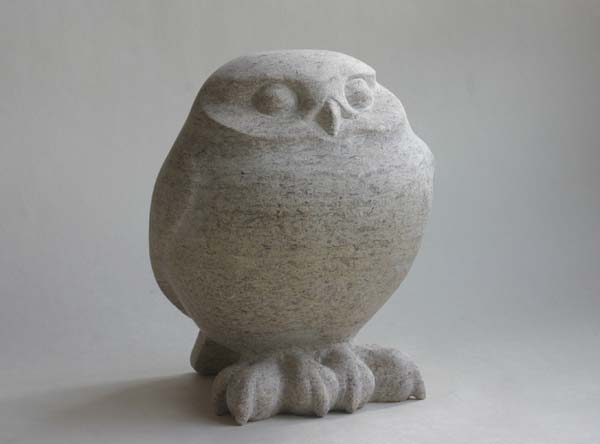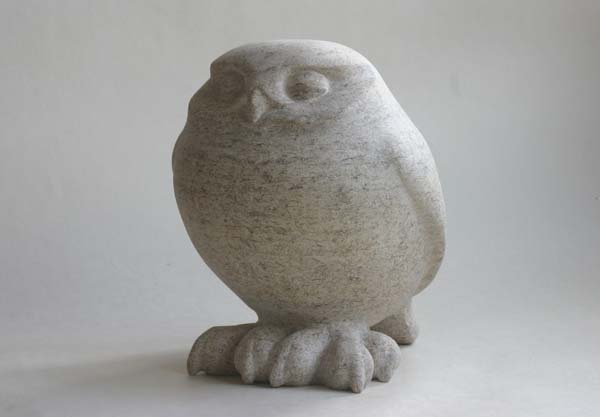Little Owl Sculpture

This is the first time I’ve carved Ancaster Weatherbed stone. This piece was so beautifully flecked grey and brown that I thought it perfect to suggest the feather colouring of a Little Owl.
I’ve worked Ancaster limestone before, but that was the stone the quarry describes as Hard White. Within the beds (the layers and strata of stone formation) there are differences in the stone colour and quality. The Hard White is actually a softer stone than the Weatherbed – just to confuse things.
Because it is denser and harder, the Weatherbed will polish, and I’m wondering whether I take my Little Owl a few stages further to get a finish. Polishing does bring out more the colours and markings within the stone – and this is enticing. Probably not evident from the pictures here, but showed up a lot when the stone was wet, are the difference in the texture of the stone. At the top of the owl’s head, the speckles are quite fine, but they got larger, rounder and more colourful as I worked down towards the feet, which almost give the appearance of translucent cork. These are all within the stone, the surface is smooth – it is like looking into the depths of the stone’s formation, so very far back.

I have another piece of this Weatherbed, different in character and more evenly and finely marked – which is an opportunity to get to know it and its mysteries better.
Little Owl sculpture will be one of the pieces shown at the White Fox Gallery in May.

12 Comments
very sweet little owl. I rather like the unpolished finish but your remarks about bringing out the color is enticing. but I wonder if it would interfere with the form. also, I was wondering if oiling it would have the same effect as polishing it re bringing out the colors.
I think you’ve decided me Ellen, I’m going to leave it as is. I do quite like the softness, and it will actually, as time goes on, and people touch and stroke it, become patinated by handling – which I very much like the idea of. Oiling certainly would bring out the colour, but also leave a rather sticky surface, onto which dirt and dust loves to adhere. I do like natural – just the stone, in all its bare stoniness. Thanks for your help!
I was going to say don’t polish, then read Ellen’s comment and your reply :o)
You’ve captured the confidence of a Little Owl perfectly.
Thankyou for your lovely comments – glad you think I’ve probably made the right decision too. I always thought that they were native owls, but in gathering information before this carving (getting into owl mode) I discovered that they were introduced in the 1980’s with great success, but lately have been struggling. They are confident characters aren’t they?
I didn’t know that about Little Owls being introduced. The info I looked at said 1840s, which is not all that long ago. I’m assuming our old friend habitat loss is responsible for their recent decline in the UK. Apparently, they are also declining in Europe, which is further bad news. The BTO website is a great resource for all things birdy, if you don’t already know of it.
I read it was enthusiastic Victorians who made the introduction – it all becomes rather complicated when categories are set for protection/research/policy or whatever when these apply to ‘native species’ – I think now the Little Owl has been classed as native, but there are many others that haven’t and still need our help. Agree re BTO website – I’ve spent many happy hours doing BTO survey squares, and go to them often for info.
I half expect to see his? her? chest expand with a breath!
That is a lovely way of seeing. I do sometimes imagine that when I shut the workshop door in the evening pieces come to life. In the morning I sometimes creep up and burst in, hoping to catch them unawares and up to whatever it is they’re at. On occasion they surprise me as I seem to have forgotten just what they look like.
Beautiful sculpture Jennifer. Owls are so fascinating aren’t they and you have captured the Little owl’s character perfectly.
Thankyou Sarah, you have just the most wonderful image of a Little Owl on your blog – they’re such active ‘alive’ birds, that it is difficult to set one point of stillness to portray. As you say, they are fascinating, endlessly so.
Jennifer, I feel inspired by your site – what you do and the creative practice that you share. I nominate you for a Very Inspiring Blogger Award here:
http://carolinegillwildlife.blogspot.co.uk/2015/03/inspiration-and-inspiring-bloggers.html
Caroline thankyou! I’ll raise a glass with you to celebrate blogs, writings, journals, musings – whatever they’re called – cheers all!